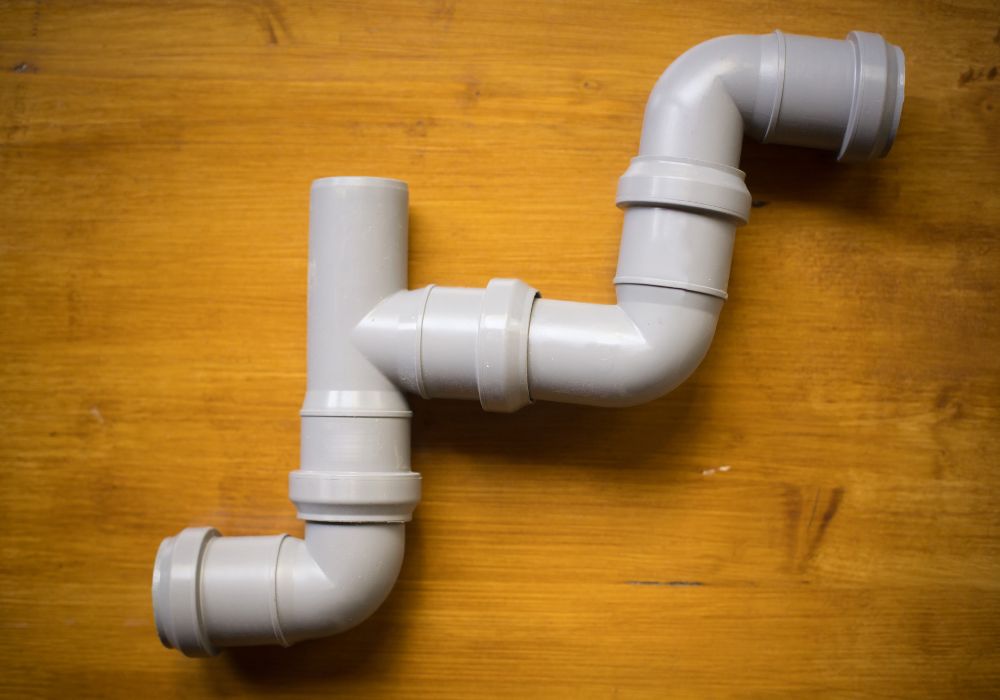The plumbing rough-in for a kitchen sink prepares the sink’s water supply and drainage system before installing the sink. It involves ensuring that the water supply and drain lines are in the correct position and have the right fittings and connections.
What Is The Rough-In Height For Sink Drains?

If you’re planning a bathroom renovation or just installing a new sink, you may have come across the term “rough-in height” for sink drains. But what exactly does this term mean, and why is it essential to consider it when installing a sink?
In plumbing terms, the rough-in height refers to the distance from the floor to the center of the drain opening in the bathroom. This measurement is crucial because it determines the placement of the sink drain and the plumbing that connects to it.
The rough-in height for sink drains is typically around 16 inches from the finished floor. This height is necessary to allow enough space for the drain trap and waste piping to be installed properly.
Ensuring accurate rough-in measurement is essential to prevent leaks or drainage issues. Suppose you need clarification on the rough-in size for your sink drain. In that case, it’s best to consult a licensed plumber or refer to your local plumbing codes and regulations.
How To Measure Kitchen Sink Drain Rough-In Plumbing Height?
You will need a measuring tape and a level to measure the rough-in height for your kitchen sink drain plumbing. The rough-in height for sink drains can vary depending on several factors, such as the size and style of the sink, the height of the person using the sink, and local plumbing codes.
Here are some general guidelines for determining the proper rough-in size:
- First, locate the center of the drainpipe in the wall or floor where the sink drain will connect.
- Measure the distance from this point to the finished floor, and subtract the sink’s depth and the drain trap’s height. This calculation will give you the rough-in size for the sink drain plumbing.
- Double-check your measurements with a level to ensure accuracy.
Following local plumbing codes and regulations is essential when determining the rough-in height for your kitchen sink drain.
Suppose you need more clarification about the process or have any doubts. In that case, it’s best to consult a licensed plumber for assistance.
Factors To Consider In Sink Drain Rough-In Height
When installing a sink, determining the rough-in height for the drain is a critical step in ensuring a properly functioning plumbing system.
There are several factors to consider when choosing the ideal rough-in size for a sink drain, including the depth of the sink, the type of drain trap being used, local plumbing codes and regulations, and the overall design and placement of the sink within the space.
By carefully considering these factors, you can ensure that the sink drain rough-in height is accurate and meets all requirements for a successful installation.
The Counter Height
It’s essential to remember that the counter’s height can significantly impact the sink’s overall height. To ensure users’ comfortable and functional height, you’ll want to ensure the sink is positioned correctly, with the top flush with the top of the counter.
However, it’s also crucial to consider additional height requirements for things like drain traps and local plumbing codes and regulations that may affect the sink’s drain rough-in height.
By carefully considering these factors, you can ensure a successful plumbing installation for your sink.
And you need clarification on any of these factors. In that case, it’s always a good idea to consult a licensed plumber for guidance.
The Location Of Your P-Trap
When determining the rough-in height for your sink drain, it’s essential to consider the location of your P-trap. This is a crucial component of your sink’s plumbing system, as it helps to prevent sewer gases from entering your home.
The position of your P-trap will affect the overall height of your sink drain rough-in. Ideally, the P-trap should be located beneath the sink and as close to the drain as possible. This will ensure that the sink drains correctly and that the P-trap is effective.
However, you should also consider any additional height requirements for the drain line and any local plumbing codes and regulations that may impact the sink drain rough-in height.
By carefully considering these factors, you can ensure a successful and adequately functioning plumbing installation for your sink.
The Size of Your Sink
The size of your sink can impact its overall height, affecting the distance between the drain and the finished floor. Typically, larger sinks require a higher rough-in height than smaller sinks.
For example, a 33-Inch Drop in Workstation Kitchen Sink
This is because larger sinks will sit higher on the counter and require more clearance below the sink for the P-trap and drain line.
It’s also important to consider any additional height requirements for the drain trap and local plumbing codes and regulations that may impact the sink drain rough-in height.
Pipe Connections

The height of the drain pipe that connects to your sink drain can significantly impact the overall size of your sink and affect the distance between the drain and the finished floor.
To ensure a successful plumbing installation, it’s essential to ensure that the drain pipe height is appropriately aligned with the rough-in height of the sink drain.
In addition, you should also consider the size and material of the drain pipe, as well as any necessary fittings or connectors that may be required to make the connection. These factors can lead to leaks or clogs in the sink drain.
Can Kitchen Sink Drain Heights Be Adjusted?
In many cases, the height of a kitchen sink drain can be adjusted to ensure proper alignment with the finished floor height. This may be necessary if changes to the sink or countertop affect the drain height or if the rough-in height of the drain does not align with the finished floor height.
To adjust the drain height, disconnect the drain pipe from the sink and make any necessary adjustments to the drain assembly. This may involve adding or removing pipe sections or adjusting the drain basket’s position or P-trap.
Once the adjustments are made, the drain pipe can be reconnected and tested for leaks. Ensure that the drain is appropriately aligned with the sink and countertop and that all connections are secure before using the sink.
How Far Should a Sink Drain Be From The Wall?
A vent helps to equalize pressure in the plumbing system and prevents sewer gases from entering your home. In most cases, a vent can be installed through the roof or an exterior wall.
The location of the vent will depend on several factors, including the layout of your plumbing system and any local plumbing codes or regulations.
It’s essential to consult a licensed plumber to determine the best location and size for your vent. Without proper ventilation, your sink drain may experience slow drainage, gurgling noises, or unpleasant odors.
A Step-by-Step Guide On How To Rough-In A Kitchen Sink Drain
Installing a kitchen sink drain can seem daunting, especially for those with little to no plumbing experience. However, with the right tools and guidance, it’s a task that most DIY enthusiasts can accomplish.
This article will provide a step-by-step guide on rough-in a kitchen sink drain, including the tools and materials needed and some tips and tricks to ensure a successful installation.
To begin the rough-in process for a kitchen sink drain, you’ll need the following tools and materials:
- P-trap
- Drain tailpiece
- Slip joint pliers
- Pipe cutter or hacksaw
- Plumbers putty
- Adjustable wrench
- Teflon tape
- PVC pipe and fittings (if necessary)
The plumbing rough-in for a kitchen sink involves several steps that must be followed to ensure proper installation. Here are the steps involved:
Step 1. Plan the location of the sink
Installing the drain assembly is the first step in rough-in a kitchen sink drain. This involves attaching the sink strainer and tailpiece to the sink basin and connecting the P-trap and drainpipe to the rough-in plumbing.
First, assemble the sink strainer by placing the gasket and washer onto the strainer body and inserting it into the sink drain hole. Tighten the locknut underneath the sink to secure the filter in place.
Next, attach the tailpiece to the filter and connect it to the P-trap. The P-trap should be positioned to align with the rough-in plumbing and provide enough clearance for the drain pipe. Once the P-trap is in place, connect the drainpipe to the rough-in plumbing using the appropriate fittings and connectors.
It’s vital to ensure that all connections are secure and free of leaks before moving on to the final step of roughing in the kitchen sink drain.
Step 2. Install the water supply lines
After the sink’s location has been determined, the next step is to install the water supply lines. The water supply lines are typically installed in the wall behind the sink. They must be installed correctly to ensure the sink has a sufficient water supply.
The exact process may vary depending on the type of faucet and sink. Still, it typically involves connecting the lines using compression fittings or threaded connections. Follow the manufacturer’s instructions carefully and use any necessary tools or sealants to ensure a secure connection.
Step 3. Install the drain lines
After determining the sink’s location and installing the water supply lines, the next step is to install the drain lines. It’s important to measure the height of the sink’s drain outlet to ensure that the rough-in size of the drain line is at the correct height.
You must connect the P-trap to the sink and drain lines to install the drain lines. The P-trap is a U-shaped pipe that prevents sewer gas from entering the home. The drain line should be sloped slightly downward towards the main drain line to ensure proper drainage.
After connecting the P-trap and drain line, you can click the drain line to the main line using PVC pipe and fittings. Be sure to secure all connections with PVC cement.
Finally, it’s necessary to test the drain lines for leaks by running water through the sink and checking for any signs of water leaking from the connections. If there are any leaks, tighten the connections and test again until no leaks are present.
Step 4. Install the vent pipes
The vent pipes are essential to the plumbing rough-in for a kitchen sink. They help prevent sewer gases from entering the home and ensure the drain system operates correctly. The vent pipes must be installed correctly to ensure that they function properly.
Vent pipes prevent odors and gases from accumulating in the drain lines. The location of the vent pipes should be planned carefully to ensure they connect to the drain lines correctly.
To install vent pipes:
-
- Determine the location of the vent stack, which is usually placed on the wall or the roof.
- Run a vent pipe from the sink drain to the vent stack and attach it using a connector.
- Ensure the vent pipe is installed with the correct slope for proper drainage.
- Ensure that the vent pipe is at least 6 inches above the overflow level of the sink to prevent water from flowing back into the vent pipe.
Once the vent pipe is installed, test it for leaks and proper function. This can be done by pouring water down the sink drain and checking for any gurgling sounds or slow drainage.
Step 5. Test the system
After all the plumbing connections have been made, the system must be tested to ensure it functions correctly. The water supply and drain lines must be tested for leaks, and the vent pipes must be tested to ensure they work perfectly.
Turn on the water supply and let the sink fill up with water. Once the sink is complete, let the water drain out while observing the drain and vent pipes for leaks. You can also use a plumber’s snake to check for any clogs in the drain.
Make any necessary adjustments to the pipes to ensure that the sink drains correctly and without leaks. Once you are satisfied with the system, the rough-in is complete, and you can install the sink.
What’s Better: Rough-In Sink Drain Through the Floor Or Wall?
When installing a sink drain, you decide: should you run the drain line through the floor or the wall? Both options have their benefits and drawbacks, so it depends on your specific situation.
Running the drain line through the floor can be smart if you’re tight on space behind the sink or dealing with an island or peninsula that doesn’t have nearby walls.
However, this option can be more complex and time-consuming, especially if you’re working with a concrete slab foundation or must run the drain line a long distance to reach the main sewer line.
On the other hand, running the sink drain through the wall can be more straightforward, especially if you’ve got a wall nearby that you can use.
Plus, this method lets you use a shallower trap, which can save space under the sink. However, be aware that this option can be trickier if you’re dealing with a load-bearing wall or if there are other obstacles in the way.
Ultimately, whether to run the sink drain through the floor or the wall depends on your specific situation and preferences. Consider the sink’s location, the proximity of walls and sewer lines, and any other factors that might impact the installation process.
What Is the Slope Of a Kitchen Drain Pipe?
The slope of a kitchen drain pipe is the angle at which the pipe is installed. It is important to have the correct slope to ensure water flows smoothly and efficiently through the line without blockages or backups.
The standard slope for a kitchen drain pipe is typically 1/4 inch per foot (2% slope). This means that for every foot of horizontal distance, the pipe should slope downwards by 1/4 inch.
However, the slope may vary depending on your area’s plumbing code and kitchen layout. It is essential to consult a professional plumber to ensure your kitchen drain pipe has the correct slope for optimal performance.
Can You Put a 90 Elbow In a Sink Drain?
Yes, using a 90-degree elbow in a sink drain is perfectly fine. It’s a standard plumbing fitting used to change the direction of the pipe.
However, it’s worth noting that using too many 90-degree elbows can create a bottleneck in the plumbing system, resulting in blockages and clogs.
It’s advisable to use 45-degree elbows instead, as they offer a smoother transition for the water flow.
Moreover, adhering to the local plumbing codes and regulations is essential when modifying the plumbing system.











